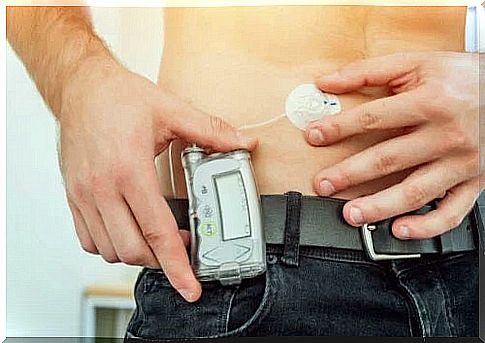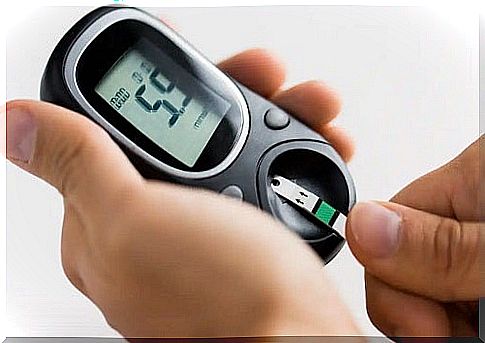What Is An Insulin Infusion Pump?

The insulin infusion pump is a device used to treat certain cases of diabetes. Insulin is the molecule that allows glucose to enter the body’s cells. Glucose, in turn, is the fundamental nutrient that cells need for energy.
What happens in diabetes is that the body cannot produce or use insulin. Therefore, the blood sugar level rises above the appropriate concentration. This causes all the symptoms and complications of the disease.
The insulin infusion pump is very useful for people who have poor blood sugar control or for those who need more flexibility in their daily routine, such as athletes. In this article, we explain how it works and what are the advantages and disadvantages of the insulin infusion pump.
How does the insulin infusion pump work?
The infusion pump is a small device that is programmed to deliver insulin into the adipose tissue under the skin. It is also called a continuous subcutaneous insulin infuser.
In many diabetics, especially type 1, treatment is based on the administration of insulin by subcutaneous injection. The problem is that patients need to have strict control to avoid chaotic glucose levels.
The infusion pump, as explained in an article in the University of Navarra Clinic, automatically administers insulin before meals. The patient no longer has to make injections.
This device is programmed according to the specific needs of the sick person. Specifically, the doses and frequency of administration are determined based on a previous study of each case of diabetes.
As mentioned, the insulin infusion pump is a small device. It is important to emphasize again that it is not a smart device, but must be pre-programmed to perform its function.
The pump works thanks to a small electric motor. This motor, with the help of a piston, pushes the drug cartridges into the tissue. As an article in Diabetes Education Online explains, most pumps contain an insulin tank, a battery, a display and the pump mechanism.
The device is placed outside the body and connected to the subcutaneous tissue using a catheter that has a Teflon cannula. The insulin infusion pump can be attached to a specially designed belt or even carried in your pocket.
When is the insulin infusion pump needed?
The insulin infusion pump may be needed to improve the control of certain cases of type 1 diabetes. According to an article in Medtronic, it is indicated when good glucose control is not achieved, despite the administration of effective treatment.
Many patients treated with insulin on a regular basis have frequent episodes of hypoglycaemia. It is also an indicator of poor blood sugar control.
The insulin infusion pump can be used for diabetics who require low doses. Similarly, it is the ideal treatment for those who need flexibility in routine, ie those who are not so eager to inject this substance in a conventional way. This is the case for athletes, especially those for whom physical activity is a profession.
Women who intend to become pregnant, as well as patients with diabetic neuropathy, are also ideal candidates for this treatment. However, the insulin infusion pump requires the patient to meet certain requirements.
It is essential to be involved in pathology and to show interest in good glycemic control. In addition, you must learn to operate the pump and perform sufficient daily blood glucose checks.
Advantages of the insulin infusion pump
The insulin infusion pump, as mentioned in this article, has many advantages. It allows very effective control of the insulin dose. Due to this, the quantities can be adjusted easily, which is very useful for children.
In addition, the pump allows you to program the basal insulin rate at different speeds, depending on the time of day. For example, higher in the early hours of the day and lower throughout the night. This reduces the risk of hypoglycaemia.
The insulin infusion pump makes it possible to temporarily change the basal infusion. This is very useful in the case of routine variations: for example, you go on a trip and change your diet.
disadvantage
Although it may seem that the insulin infusion pump has only advantages, the truth is that it is not without its drawbacks. We must keep in mind that it is an external device, which must remain permanently connected to the body through the catheter.
You can’t take her out whenever you want, you can’t even sleep. This is why many people feel uncomfortable or attached to the device. In fact, some consider it to have an aesthetic impact because it can be seen through clothing.
The catheter may become clogged or the pump itself may malfunction. This means that the patient loses control of their blood sugar. Therefore, it is important that people who wear it check it daily.
Care and recommendations

The insulin infusion pump requires the patient to be aware of his illness and to be responsible for the treatment. It is necessary to apply a series of measures of care of the device.
According to the Diabetes Foundation, the subcutaneous catheter should be changed every 2 or 3 days. Because it is a foreign body connected to the subcutaneous tissue, there is a risk of infection. Therefore, in order to make the change, a few concrete steps must be followed.
The first thing is to wash and disinfect your hands properly. Try to change the area where the catheter is inserted from time to time. Otherwise, insulin may not be absorbed properly. Choose different points of the abdomen. Check that it is in good condition and fill the pump syringe without leaving bubbles inside.
The skin of the abdomen must also be disinfected. Once the catheter is inserted, a bandage should be used to prevent it from dislodging. It is recommended that insulin be removed from the refrigerator approximately 24 hours before replacement.
This device requires liability
Although it may seem that this device is the solution for the treatment of diabetes, it is not always the case. It is a very useful form of treatment, but it requires the patient to be aware of what to do.
Therefore, the decision to place such a pump must be agreed by the patient and the doctor. It is important that a number of requirements are met for it to be useful.









